Encoded Cloth – Anne and Lisa
Inspiration
We were inspired by the Hong Kong protests to create a piece that would both raise awareness and show support for the protesters in Hong Kong. Both of our families are immigrants, Lisa’s from Hong Kong and Anne’s from China. Although we support the protests, some of our families are less aware of them or even against them, despite being more directly affected by them. So, we created this piece as both a homage to yet rebellion against our roots.
Our design was inspired by the Umbrella Movement, an earlier political movement in Hong Kong that remains a symbol for protesters today. The umbrella is both a commonplace item, as Hong Kong is in a tropical area, but also a symbol of solidarity between protesters and a tool for peaceful resistance and protection against tear gas. We wanted to make a utilitarian garment that could be worn by a person to speak out against the humanitarian and political injustices faced by people in Hong Kong. So, we decided to design a poncho with eight umbrella-like panels to showcase different fragmented snapshots of the protests.
We structured the panels in pairs that would be placed adjacent to each other, the seam of the cloth literally showing some kind of divide or contrast. We had two pairs of text panels, one that said “Free HK” in English and one that had a rallying phrase in Chinese that says “Hong Kong” one way and “Keep Going/Add Oil” the other way. We thought the Chinese phrase would have a particularly interesting effect as the cloth moves and shifts so that people can read both messages. We also had one panel with the design of the current red HK flag, and one panel with the black protest flag. Lastly, we had two panels of policemen and protesters facing each other. We used yellow for the protesters because that is the color associated with the Umbrella Movement, and purple for the police because it was dark and contrasted with the yellow. We kept a limited palette scheme because it helped emphasize the prints and the contrast between them. Colors like red and black are often symbolic of revolution or unrest, so we used a lot of those colors. We decided to print on canvas because it was a very rough, utilitarian material. The paint splatters and smudges unintentionally created the effect of blood or wounds on skin. We added a hood to the garment because the protesters often wear hoods and masks to conceal their identities.
Process
Our piece involved a lot of printing. We first created the designs for each panel, then cut them out of contact paper for screen printing and foam for block printing. The first prints that we did were screen printing the text panels We found that cutting out the fine details of the text with the X-acto knife, especially the Chinese characters, was very difficult and time-consuming. The screen printing itself was also a difficult process, but everything paid off with the sharp detailing on the screen print.

Afterwards, we block printed all the other designs.
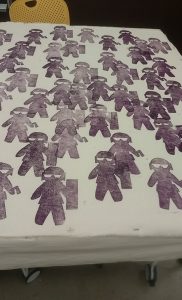
Finally, after all the printing was done, we cut the printed fabrics into triangles and sewed them radially into a rectangular shape. From this combined piece, we cut out the poncho pattern and cut out the hood from remaining fabric. We experimented with various details, such as finishing the edges, but eventually concluded that it looked better and more symbolic with the frayed texture of the canvas.
Final Product/Thoughts
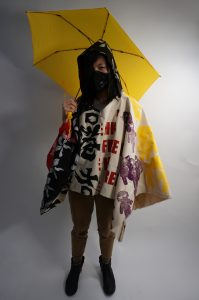
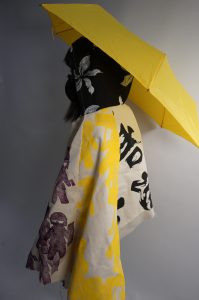
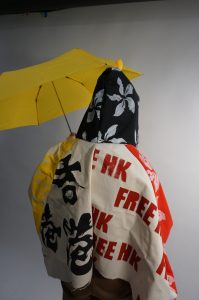
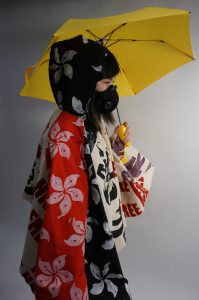
We were very satisfied with the final result. We learned a lot about different techniques such as screen printing, block printing, and sewing through their various applications on this garment. We learned that the process was not as straightforward as we initially thought, as we had to redo a lot of the stencils and sewing that we didn’t get right the first time. We discovered the various advantages and disadvantages of different kinds of printing, and the trade off between time and print resolution. Ideally, we hope that this garment can be worn around campus or another public space to serve its intended purpose of raising awareness and making a statement.